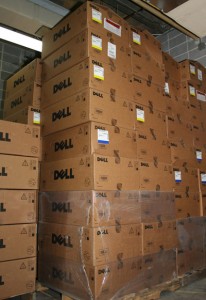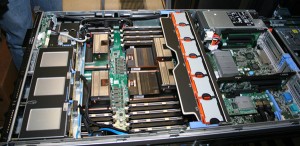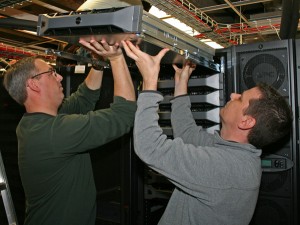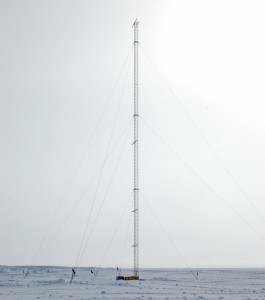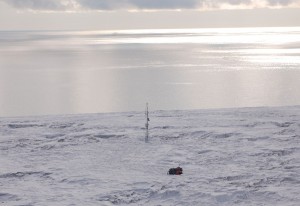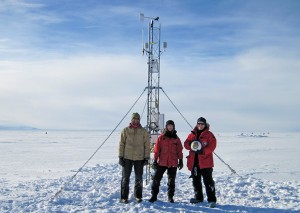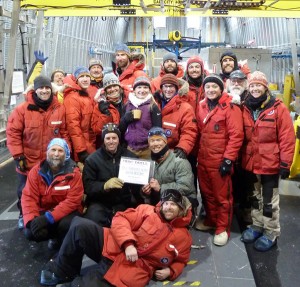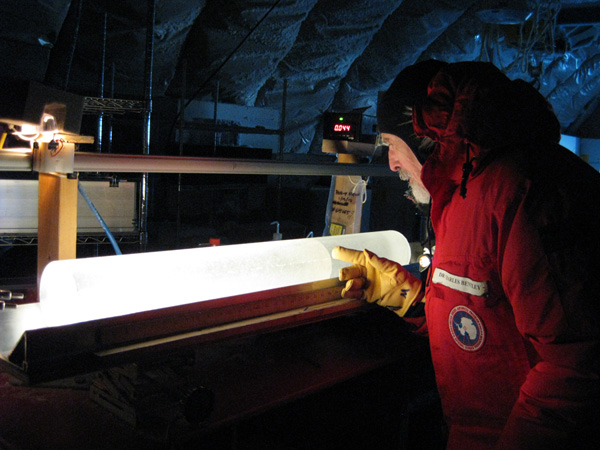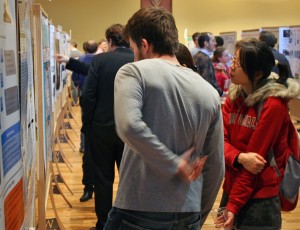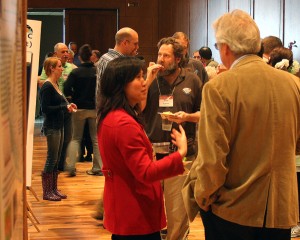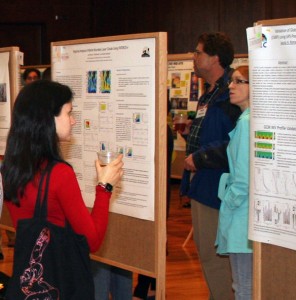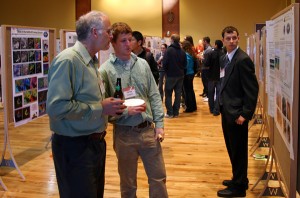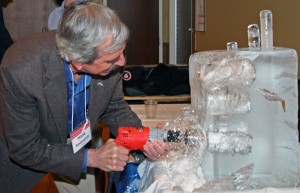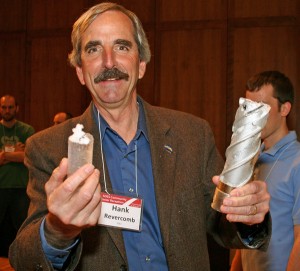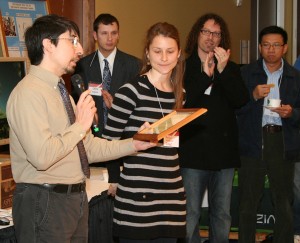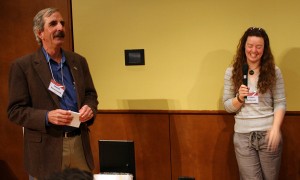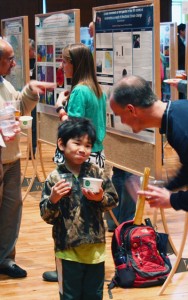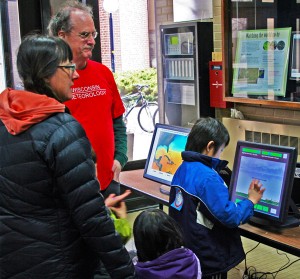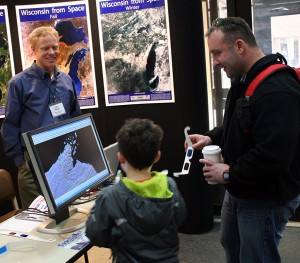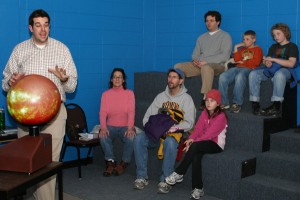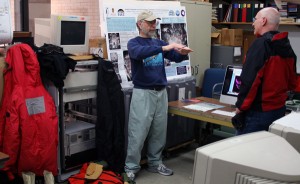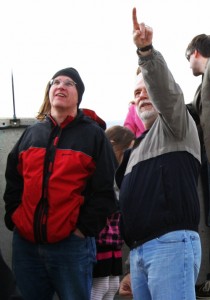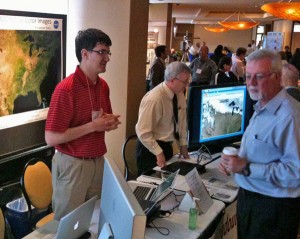Monthly News Summary – May 2011
- Million Dollar Super-Computer Comes to SSEC
- 2010-2011 Antarctic Automated Weather Station Field Season
- World-wide Congratulations for Record-Breaking Drilling in Antarctica
- And While We’re on the Topic of SSEC’s Drilling Efforts in the Antarctic…
- First Annual AOSS Community Poster Reception A Big Hit
- 9th Annual Science Expeditions Explores AOSS
- 2011 NOAA Direct Readout Conference
- Presentations at 34th International Symposium for Remote Sensing of Environment
- Manuscript Published
Million Dollar Super-Computer Comes to SSEC
The largest, most powerful computer on the University of Wisconsin-Madison campus begins operations in June of 2011. Housed at the Space Science and Engineering Center (SSEC), the new system will contain 3,072 CPU cores, 8 terabytes of RAM, over 450 terabytes of disk space, and a 40 gigabit infiniband network. The system is more than half again as large as any previous campus high performance computer cluster.
Funded by the National Oceanic and Atmospheric Administration (NOAA), the system will be used by NOAA and UW researchers to run data assimilation experiments with the goal of improving the NOAA operational weather models used to generate weather forecasts for the United States.
The NOAA National Environmental Satellite, Data and Information Service (NESDIS), Center for Satellite Applications and Research (STAR), approached Principal Investigator Liam Gumley and his team with a proposal to provide a million dollar grant to design a large, extremely capable system and, upon approval of the design, purchase the hardware. They required that the system be able to run NOAA’s operational, data assimilation, and numerical weather prediction models, and to serve as a test bed to develop and improve the use of satellite measurements in numerical weather prediction.
Stacks of boxes holding the processors and memory units loomed large in the loading dock.
SSEC Technical Computing staff including Jesse Stroik, John Lalande, and Technical Lead Scott Nolin created the design proposal using NOAA’s parameters and critical guidance from Science Lead Brad Pierce and other SSEC scientists. When the design was approved by NOAA, the team procured the equipment.
The interior of a Dell unit.
SSEC provides complete administration services for the system. 90% of the system’s capacity will be used by NOAA’s STAR researchers. The other 10% is assigned to SSEC.
Endre Doeringsfeld and Paul Czerniak install a component.
The supercomputer system will be used to enhance the accuracy of weather prediction systems through improved use of satellite data within the U.S. operational data assimilation and forecast systems, at global and regional scales. Applications include studying the impact of future observing systems, such as the Advanced Baseline Imager on future GOES satellites, on the forecast skills of U.S. Numerical Weather Prediction models.
NOAA’s desire is for a top-flight system that is accessible and easy to use, and SSEC and the University of Wisconsin is working hard to meet those goals.
2010-2011 Antarctic Automated Weather Station Field Season
The 2010-2011 Antarctic field season was one of the most successful on record. SSEC’s Antarctic Meteorological Research Center sent three researchers to Antarctica during the December-February months – Jonathan Thom and Lee Welhouse from UW-Madison and Melissa Nigro from the University of Colorado-Boulder. The plan was to service, remove and add various weather stations throughout the continent. The AMRC was hoping to service seven stations, remove three stations, and install two stations, all of which was completed successfully! Nearly two-dozen AWS sites were visited this year by the field team or collaborating field parties from other nations.
Scientists can normally expect a few complications during a typical field season: weather can delay operations significantly so that at least one or two tasks do not get completed. However, this year, there were no weather problems and everything went smoothly.
The installation of one station was highly anticipated by the Antarctic community: Tall Tower. Located on the Ross Ice Shelf, this tower stands 100 feet (30.5 meters) and remains one of the greatest accomplishments of the 2010-2011 field season.
Tall Tower AWS located 100 miles south of McMurdo Station, on the Ross Ice Shelf.
(Photo Courtesy of Melissa Nigro)
Another success story was the servicing of Whitlock AWS on Franklin Island – accomplished during a short ship cruise on the Oden Icebreaker.
New Whitlock AWS on Franklin Island, in the Ross Sea, North of McMurdo Station.
(Photo Courtesy of Melissa Nigro)
Lee Welhouse (left) with help from RSPC staff Todd and Cecelia at Janet AWS site.
Submitted by Elena Willmot.
World-wide Congratulations for Record-Breaking Drilling in Antarctica
Kendrick Taylor, chief scientist on the WAIS Divide Ice Core Project, forwarded a stack of congratulatory emails received from all over the world, enthusing over the record-breaking efforts of the SSEC-designed and built DISC drill and the drilling team.
Core handlers and drillers. Last core of 2010-2011.
(Photo credit: Jay Johnson)
Dr. Charles Bentley, IDDO P.I., with ice core at WAIS Divide camp, Antarctica
(Photo credit: Krissy Dahnert)
And While We’re on the Topic of SSEC’s Drilling Efforts in the Antarctic…
Take note that the Blue Ice Drill project and Lead Driller Tanner Kuhl were featured on public radio.
First Annual AOSS Community Poster Reception A Big Hit
Looking very much like an “in-house conference” (and conveniently located just across the street at the new Union South), the first annual AOSS Community Poster Reception on 26 April 2011 was a resounding success.
Filling the Union’s Varsity Hall from wall to wall, 99 posters illustrated current work going on in the AOSS Building, including the Space Science and Engineering Center, the Cooperative Institute for Meteorological Satellite Studies, Ice Coring and Drilling Services, and the Antarctic Meteorological Research Center.
Video displays highlighting meteorological studies, an interactive kiosk illustrating the Venus Express program, and a hands-on ice drilling exhibition rounded out the successful reception.
SSEC Director Hank Revercomb drills the ice…
…and scores a perfect core.
Michael Notaro announcing the Reid Bryson Scholarship winner —
Rachel Licker from Sustainability and the Global Environment. (SAGE).
Approximately 250 people attended the event (http://www.ssec.wisc.edu/aoss_posters/). Hopes are high that this becomes an annual celebration of the wide range of valuable science being achieved in the AOSS Building.
Very special thanks to the AOSS Community Poster Reception Committee formed by Claire Pettersen for a great idea and for bringing it to life.
Hank Revercomb and Claire Petterson.
Claire Pettersen, Committee Chair
Ankur Desai, AOS and CCR
Maria Vasys, SSEC and CIMSS
Mat Gunshor, SSEC and CIMSS
Linda Hedges, Schwerdtfeger Library
Mark Kulie, AOS
Jean Phillips, Schwerdtfeger Library
Eric Thompson, SSEC
…and a good time was had by all.
9th Annual Science Expeditions Explores AOSS
Enthusiastic learners of all ages flooded the UW-Madison campus on Saturday, 2 April 2011 for the 9th Annual Science Expeditions.
On hand to give the explorers a good luck at the work done in the AOSS Building were:
Tom Whittaker with weather apps (and guiding groups up to the roof).
Sam Batzli presenting WisconsinView.
Patrick Rowley (pictured) and Rick Kohrs illustrating Science on a Sphere.
George Weidner giving tours of Antarctica.
Dave Jones (pictured), Mark Hobson, and Ross Dixon answering questions on the roof.
2011 NOAA Direct Readout Conference
The 2011 NOAA Direct Readout Conference was held 4-8 April 2010 in Miami, FL. There was strong international participation, with 29 countries represented. Tim Schmit was a program committee member, abstract committee chair, session co-chair, presenter, and subject matter expert during the break-out session on Geostationary Operational Environmental Satellites (GOES) transition issues.
The Space Science and Engineering Center (SSEC) had a booth where Jordan Gerth, Liam Gumley and Kathleen Strabala exhibited products supporting Aqua and Terra Direct Broadcast. Along with promoting the use of the MODerate Resolution Imaging Spectroradiometer (MODIS), Atmospheric Infrared Sounder (AIRS) and AMSR-E (Advanced Microwave Scanning Radiometer for EOS) data, live demonstrations of some of the new International MODIS/AIRS Processing Package (IMAPP) software releases were shown at the SSEC booth, including the IMAPP Virtual Appliance, a complete, free, level 0 to level 2 processing system for Aqua and Terra that can be installed and run on Linux, MacIntosh and Windows operating systems.
Jordan Gerth and Dave Santek demonstrate data and products created using software distributed as part of the International MODIS/AIRS Processing Package (IMAPP).
Presentations at 34th International Symposium for Remote Sensing of Environment
Steve Ackerman gave talks at the 34th International Symposium for Remote Sensing of Environment, both on NOAA related projects. The first, titled “Trends in Satellite Observations of the Great Lakes” was done in collaboration A. Heidinger and B. Maddux and explored trends in cloud cover as seen by MODIS and AVHRR (PATMOS-x). There are interesting spatial patterns in cloud cover. For example, the Great Lakes are more cloudy than the land regions during winter, while in summer the cloud amounts are similar. No long-term trend in cloud cover over the Great Lakes was detected in the PATMOS-x product.
The second talk, “A Global Perspective of Scientific Visualization: Developing Impacting and Understandable Imagery to Engage Audiences” was presented in the session “Thrilling Imagery and the Science of Design: Engaging the Public with Remote Sensing.” The talk was co-authored with D. Pisut and discussed our collaborative NOAA project on how best to incorporate real-time and climate data sets on the sphere, while providing appropriate docent training.
A manuscript entitled “Pollution from China increases cloud droplet number, suppresses rain over the East China Sea” written by Ralf Bennartz, Jiwen Fan, John Rausch, L. Ruby Leung, and Andrew K. Heidinger, is being published in Geophysical Research Letters, vol. 38, LXXXXX, doi:10.1029/2011GL047235, 2011. The paper illustrates that rapid economic growth over the last 30 years in China has led to a significant increase in aerosol loading, which is mainly due to the increased emissions of its precursors such as SO2 and NOx. These changes significantly affect wintertime clouds and precipitation over the East China Sea downwind of major emission sources.

